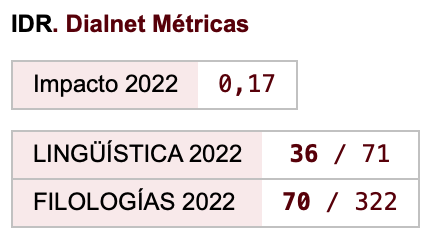Didactics and phonology of French as a foreign language in a Spanish-speaking environment
Keywords:
Phonology, Phonetics, French, Spanish, Second Language AcquisitionAbstract
Phonetics is basic to phonology and both are important components of Foreign Language teaching / learning. What was defined as a phonemic contrast by the Prague phonologists is key in Foreign Language didactics. How many phonemes shall we teach in French as a foreign language for example? And which is the scientific background of a “correct” pronunciation? A phonetic approach based on phonemic contrast gives detailed and surprising answers and these answers affect Foreign Language didactics, especially beginning levels. The traditional alphabet approach to learn the sounds of a foreign language is not able to treat phonological challenges or disability. Furthermore, a good knowledge of the phonemic contrasts of both source and target languages will help teachers to emphasize specific points and to decode pronunciation and comprehension issues. In sum, the study of phonemic contrasts in target and source languages, as well as a global phonological awareness are more likely to develop efficient oral skills.
Downloads
References
Arrivé, M., Gadet, F. & Galmiche, M. (1986). La Grammaire d’aujourd’hui. Guide
alphabétique de linguistique française. Paris: Flammarion.
Arnauld, A. & Lancelot, C. (1768). Grammaire générale et raisonnée [avec des
remarques de Charles Duclos]. Paris: Prault père. Première édition en 1660.
Bachelard, G. (2003). L’eau et les rêves. Paris: Flammarion. Première édition en 1942.
Boyer, H., Rivera, M. (1979). Introduction à la didactique du français langue étrangère. Paris: Clé international.
Boyer, H., Butzbach, M. & Pendanx, M. (1990). Nouvelle introduction à la didactique du français langue étrangère. Paris: CLE international.
Catach, N. (1994). Le rôle de l’écrit dans l’acquisition d’une langue étrangère, ou l’utilisation des compétences. In Buridant, B. & Bunjevac, M. & Pellat, J.- C. (Eds), L’écrit en français langue étrangère. Strasbourg: Presses Universitaires de Strasbourg, 121-129.
Cuq, J.-P. & Gruca, I. (2002). Cours de didactique du français langue étrangère. Grenoble: PUG.
Duchet, J.-L. (1981). La phonologie. Paris: PUF, coll. « Que sais-je? » no1875. Troisième édition corrigée.
Grevisse, M. (1988). Le bon usage. Paris: Duculot. 12ème édition refondue par André Goosse. Première édition en 1936.
Jakobson, R. (1963). Essais de linguistique générale. (N. Ruwet, trad). Paris: Les Éditions de Minuit.
Malmberg, B. (1954). La phonétique. Paris: PUF, coll. « Que sais-je? » no637. Dix- huitième édition.
Martinet, A. (1970). Éléments de linguistique générale. Paris: Armand Colin. Nouvelle édition remaniée de 1980.
Mounin, G. (1968). Clefs pour la linguistique. Paris: Seghers. Troisième édition. Polivanov, E. (1931). La perception des sons d’une langue étrangère. Réunion
phonologique internationale (pp. 79-96). Prague: Jednota.
Riegel, M. & Pellat, J.-C. & Rioul, R. (2002). Grammaire méthodique du français. Paris: PUF. Deuxième édition.
Saussure, F. (1979). Cours de linguistique générale. Édition critique préparée par Tullio de Mauro. Paris: Payot. Première édition en 1916.
Troubetzkoy, N. (1957). Principes de phonologie. (J. Cantineau, trad.). Première édition en 1949.
Downloads
Published
How to Cite
Issue
Section
License
Authors who publish with this journal agree to the following terms:
- Authors retain copyright and grant the journal right of first publication with the work simultaneously licensed under a Creative Commons Attribution License that allows others to share the work with an acknowledgement of the work's authorship and initial publication in this journal.
- Authors are able to enter into separate, additional contractual arrangements for the non-exclusive distribution of the journal's published version of the work (e.g., post it to an institutional repository or publish it in a book), with an acknowledgement of its initial publication in this journal.
- Authors are permitted and encouraged to post their work online (e.g., in institutional repositories or on their website) prior to and during the submission process, as it can lead to productive exchanges, as well as earlier and greater citation of published work (See The Effect of Open Access).

Revista de Lenguas para fines específicos is licensed under a Creative Commons Reconocimiento-NoComercial-SinObraDerivada 4.0 Internacional License.























